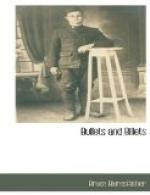This roof was perhaps rather unique as roofs go. It was a large mattress with wooden sides, a kind of oblong box with a mattress top. I found it outside in a ruined cottage. Underneath the mattress part was a cavity filled with spiral springs. I arranged a pile of sandbags at each side of the hole in the floor in such a way as to be able to lay this curiosity on top to form a roof, the mattress part downwards. I then filled in with earth all the parts where the spiral springs were placed. Total result—a roof a foot thick of earth, with a good backbone of iron springs. I often afterwards wished that that mattress had been filleted, as the spiral springs had a nasty way of bursting through the striped cover and coming at you like the lid of a Jack-in-the-box. However, such is war.
Above this roof I determined to pile up sandbags against the wall, right away up to the roof of the cottage.
This necessitated about forty sandbags being filled, so it may easily be imagined we didn’t do this all at once.
However, in time, it was done—I mean after we had paid one or two more visits to the trenches.
We all felt safer after these efforts. I think we were a bit safer, but not much. I mean that we were fairly all right against anything but a direct hit, and as we knew from which direction direct hits had to come, we made that wall as thick as possible. We could, I think, have smiled at a direct hit from an 18-pounder, provided we had been down our funk hole at the time; but, of course, a direct hit from a “Johnson” would have snuffed us completely (mattress and all).
Life in this house and in the village was much more interesting and energetic than in that old trench. It was possible, by observing great caution, to creep out of the house by day and dodge about our position a bit, crawl up to points of vantage and survey the scene. Behind the cottage lay the wood—the great Bois de Ploegstert—and this in itself repaid a visit. In the early months of 1915 this wood was in a pretty mauled-about state, and as time went on of course got more so. It was full of old trenches, filled with water, relies of the period when we turned the Germans out of it. Shattered trees and old barbed wire in a solution of mud was the chief effect produced by the parts nearest the trenches, but further back “Plugstreet Wood” was quite a pretty place to walk about in. Birds singing all around, and rabbits darting about the tangled undergrowth. Long paths had been cut through the wood leading to the various parts of the trenches in front. A very quaint place, take it all in all, and one which has left a curious and not unpleasing impression on my mind.




